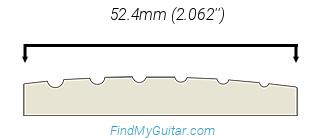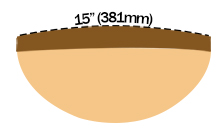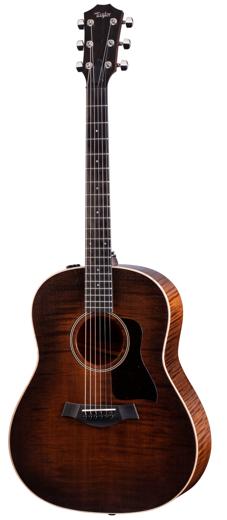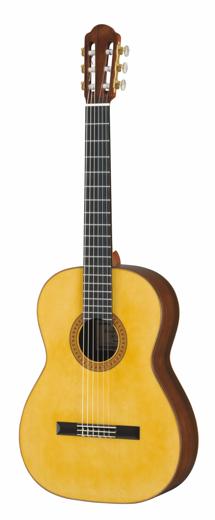Taylor AD27e Flametop vs Yamaha GC82S
Reasons to Get
Taylor AD27e Flametop over Yamaha GC82S
Reasons to Get
Yamaha GC82S over Taylor AD27e Flametop
Other Key Differences
Taylor AD27e Flametop vs Yamaha GC82S
Shared Features
Taylor AD27e Flametop vs Yamaha GC82S
Common Strengths
- Solid Top Wood
- Solid Side Wood
- Solid Back Wood
- High-Quality Nut
- From a High-Quality-Standards Country
Common Weaknesses
- Pickup Alter Switch/Knob
- Locking Tuners
- High-Quality Frets
- Compound Radius Fretboard
- Luminescent Sidedots
- Strap Lock
- Top Pickup Brand
- 21:1 Tuner Ratio
- Active/Passive Preamp
Price History Comparison
These are affiliate links. We may earn a fee if you purchase after clicking. These prices are prone to error. Make sure you're buying the right product after clicking on a link from our site. We are not liable if you buy the wrong product after following these links. As an Amazon Associate site we earn from qualifying purchases.
Which One is Better for Beginners?
The Yamaha GC82S meets 5 out of our 8 criteria items for beginner friendliness, while the Taylor AD27e Flametop meets only 3. This takes into account the type of frets, scale length, nut width, bridge type, fretboard radius, and neck profile to determine the easiest combination for new players.
New Player Friendliness
Taylor AD27e Flametop- Easy-to-use bridge
- Tall frets
- Comfortable neck
- Comfortable shape
- Comfortable fretboard
- Narrow nut
- Short scale
- Soft Strings
- Locking tuners
New Player Friendliness
Yamaha GC82S- Comfortable shape
- Easy-to-use bridge
- Tall frets
- Comfortable neck
- Soft Strings
- Comfortable fretboard
- Narrow nut
- Short scale
- Locking tuners
Nevertheless, when it comes to choosing an instrument, you should pick the one more compatible with your personal style. Still, below we'll try you to give you our results as objectively as it's possible to help you decide.
Sound Quality Comparison
The most important thing that will determine the tone of an acoustic guitar is the wood. Let's take a look at the differences between both .
Woods Used in the Taylor AD27e Flametop


Maple is one of the most popular necks for good reasons. It is a strong wood that is relatively cheap to make and looks beautiful. The highest quality maple is the hardest that comes from North America. Find out more about Maple.
Eucalyptus is not a common tonewood, but it's becoming more popular recently. There are many species around the world, each with its own characteristic, so it's hard to describe the tone it produces without knowing the exact species.
Woods Used in the Yamaha GC82S




This is a softwood that is commonly used for acoustic guitars. It's known for its warm tone with strong overtones. However, there are many species so the tone and look can vary a lot.
Ebony is a high-end wood, so it is not cheap. It's only used for fretboards because it's also very heavy. It does an excellent job as a durable material while looking elegant. Find out more about Ebony.
Spruce has a light color with tight grain patterns. It's very stiff but relatively light. It's known for producing a well-rounded tone with a broad dynamic range. Find out more about Spruce.
Rosewood is an almost purple-looking wood that is used mainly for fretboards since it's heavy, rare, and expensive. It's sometimes used on acoustic guitar bodies to create stronger warm tones. Find out more about Rosewood.
Winner: Yamaha GC82S.
Electronics
The Taylor AD27e Flametop comes with a preamp that allows you to connect it to an amp, unlike its competitor. This allows it to have more versatility and sound quality if you want to record with it or play live.
Winner:Taylor AD27e Flametop.
Final Sound Quality Scores
Build Quality Comparison
When it comes to build quality, we like to take into account everything used to build the instrument. This includes materials, hardware and the quality control expected depending on the country where it was built. Let's see how the Taylor AD27e Flametop compares to the Yamaha GC82S.
Country of Origin
The manufacturing country can tell a lot about the build quality of an instrument. The Taylor AD27e Flametop is built in United States while the Yamaha GC82S is made in Japan.
The United States is considered one of the best electric guitar manufacturers in the world. A guitar made in this country is supposed to have world-class quality control. Nowadays, guitars made in other countries can beat some of the ones made in the US, but most of the time, this country offers the best you can get. Of course, that comes at a price.
Japan has a long history of high-quality guitar building. Little has changed in terms of their manufacturing and quality control over the years. Many guitars made in this country can be compared—and even beat—others made in the US.
Winner: Tie
Nut Material
If you want your guitar to stay in tune and sound good, you need a well cut nut. Nut quality can be inconsistent even when comparing two copies of the same model. The best way to make sure you're nut will be well done is by getting a nut made by an expert company like TUSQ or Micarta.
The Taylor AD27e Flametop has a Ivory Tusq nut. Ivory used to be considered the best material for guitar nuts due to its beauty, durability, and the rich harmonics and sustain you could get from a guitar with it. However, the way to obtain it is simply unethical. Enter TUSQ ivory nuts, which are made synthetically to imitate ivory. Technically, it's better than ivory because it is consistent piece-to-piece, while natural materials can vary a lot, even if they're made from the same.
On the other hand, the Yamaha GC82S comes with a Bone nut. It's a type of nut found in high-quality instruments. They sound similar to Ivory since they give a lot of sustain and a bright sound (at least when striking open strings). The only problem they can run into is that you may get a bone piece that simply doesn't sound as well as others because that's just how natural materials are.
Winner: Tie.
Fret Material
Most fret wire is made of nickel silver. This material eventually wears down after a lot of use and most instruments end up needing a complete fret replacement. However, some expensive models come with stainless steel frets. This is what you should aim for if you can afford it.
Unfortunately, none of them come with stainless steel frets.
Winner: Tie.
Tuners
Both come with regular tuners. The Taylor AD27e Flametop's are Taylor Nickel while the Yamaha GC82S's are Gold (35G510QC-M)
Winner: Tie.
Here is the list of features that were considered when choosing the winner in the Features subcategory:
Taylor AD27e Flametop
- Made in United States
- Ivory Tusq Nut
- Electronics
- Ivory Tusq Saddle
- Solid Top Wood
- Solid Side Wood
- Solid Back Wood
- Cheap Fret Wire (NS)
- No Locking Tuners
- No Expensive Woods
- No Top Brand Pickups
- No Compound Radius Fretboard
- No 21:1 Tuner Ratio
- No Strap Lock
Yamaha GC82S
- Made in Japan
- Expensive Wood
- Bone Nut
- Bone Saddle
- Solid Top Wood
- Solid Side Wood
- Solid Back Wood
- Cheap Fret Wire (NS)
- No Locking Tuners
- No Top Brand Pickups
- No Electronics
- No Compound Radius Fretboard
- No 21:1 Tuner Ratio
- No Strap Lock
Final Build Quality Scores
Playability Comparison
Let's now compare their playability. Bear in mind that the instrument will feel different depending on your hand size and play style. That's why you should always test before buying. But if you can't or want a second opinion on it, we can still take a look at each of the important measurements of the instrument for you. This way, we can predict how easy a guitar might be to play, or how different it will feel compared to the other.
Remember that, even though the difference might seem small, every inch counts when it comes to feeling of the instrument in your hands. Any variation can completely change how comfortable a guitar feels in your hands.
Nut Width


The nut width will affect the separation between strings at the nut. In this comparison, the Yamaha GC82S has the wider nut with 52.4mm (2.062'') vs 44.5mm (1.75''). This is a 7.9mm (0.312'') difference
This means that it will be more difficult to do bar chords on the Yamaha GC82S, especially closer to the nut. However, it's also easier to play without muting strings accidently. This favors people with big hands.
Scale Length


The scale length is one of the things that influences playability the most. This is the distance between the nut and the bridge and will affect everything from low action allowance, difficulty to perform bends, fret separation, and even tone.
The Yamaha GC82S has the longest scale: 25.6". The Taylor AD27e Flametop is only 25.5" long. This is a 0.1'' (2.5mm) scale length difference.
This longer scale means that the strings need more tension to get in tune. This is good if you want to avoid fret buzz, which can happen when the strings are too loose and touch the frets while vibrating. This is especially important when playing in lower tunings. This will also let you reduce the gap between fretboard and strings (low action) to make them easier to press down. However, this higher tension will also make it harder to perform bends and vibratos as the strings will feel stiffer.
This also means that the frets have a longer separation between each other, so this will make it harder for people with smaller hands when playing some chord positions.
Another characteristic of a longer scale is that it makes the guitar sound 'snappier' or brighter. This is due to the extra separation between harmonics and overtones produced by the tension. This influences tone more than any other factor (except the pickups).
Lastly, remember that you can also affect the tension of the strings by changing your string gauge. You can use a thicker gauge for more tension and a lighter one for less tension.
Neck Profile


No single neck shape is better than others. However, most people tend to prefer a thinner necks because it doesn't get in their way when playing fast and most hand sizes can adapt to it pretty well. However, some people still prefer thicker necks for a better grip, especially if they have big hands.
Both the Taylor AD27e Flametop and the Yamaha GC82S have a C-shaped neck. This is what you'll find in most modern guitars. Most people feel like the thickness of a C neck is simply the less intrusive one for playing fast, while at the same time allowing you to grab the neck easily for resting if you want to.
Fretboard Radius


Most guitar fretboards are not flat; they usually have a curve or arc across their width. A curved fretboard will make it easier to perform chords without muting strings, while a flatter one will make it easier to play single notes, which is good for bending and soloing in general. The best fretboards have a compound radius that varies across the fingerboard, but they're not common since they take a lot more work to build.
In this case, the Taylor AD27e Flametop's fingerboard radius is smaller, which means it's more curved than the Yamaha GC82S's. This extra arc will make playing chords easier in this model. You won't be as likely to mute the strings, especially if you have big hands. However, playing single notes and bending will be easier on the Yamaha GC82S.
Hand Size Comfortability
Everyone has a different hand size, and that's why it's recommended to try a guitar before buying, even if others tell you that it's comfortable to play. However, we can know whether a guitar favors small or large hands just by knowing its exact measurements.
And after taking into account the scale length, nut width, neck profile and fretboard radius, we can conclude that the Yamaha GC82S favors large hands more than the Taylor AD27e Flametop.
Taylor AD27e Flametop:
Yamaha GC82S:
Fret Size

Both have a Medium fret size. If you like feeling the fretboard when you play, but also appreciate some easiness to press down the frets, this size offers a good balance for that.


















